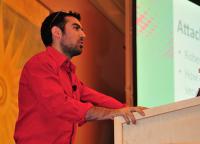-
Strategic alliance to deliver behavioral analysis cybersecurity to market
Ernst & Young LLP and Los Alamos National Laboratory have formed a strategic alliance to deliver what they describe as some of the most advanced behavioral cybersecurity tools available to the commercial market. The alliance comes at a watershed moment when increasingly sophisticated cyberattacks are inflicting significant economic, social, and even political damage to U.S. organizations. The tools developed by Los Alamos and delivered to the private sector by Ernst & Young LLP can help counter these threats by detecting them before they do deep and lasting damage.
-
-
Power safety in data centers
Power and thermal management have become a critical priority in data centers, which can use as much electricity as a small town. Energy and power vulnerabilities pose serious security threats to data centers, but so far little has been done to address these issues. A DHS grant will allow researchers to investigate energy and power safety in data centers.
-
-
DHS S&T awards $10.4 million in mobile security research contracts
The mobile technology industry has continuously expanded with new devices and apps, allowing people to simplify how and where business is conducted. While increasing the use of mobile technology can enhance productivity, improved security is needed to ensure that sensitive information is not at risk to current and emerging cyber threats. DHS S&T the other day announced $10.4 million in cybersecurity Mobile Technology Security (MTS) research and development (R&D) awards to enhance the security of mobile devices for the federal government.
-
-
DHS S&T awards U Oregon a 1.38M contract for DDoS research

DDoS attacks are used to render key resources unavailable. A typical DDoS attack might disrupt an organization’s Web site and temporarily block a consumer’s ability to access the site. A more strategic attack could make a key resource inaccessible during a critical period. DHS S&T awarded a $1.38 million contract to the University of Oregon to create technology to defend against large and sophisticated Distributed Denial of Service (DDoS) attacks. The University of Oregon’s DrawBridge project will become part of the DHS S&T Cyber Security Division’s larger DDoSD program.
-
-
Federally funded network anomaly-detection technology licensed to Ernst & Young
The Transition to Practice (TTP) program, established in 2012 as part of S&T’s Cybersecurity Division, looks to transition federally funded cybersecurity technologies from the laboratory to enterprise consumers. S&T the other day announced that the PathScan technology, a network anomaly-detection tool developed by Los Alamos National Laboratory, has been licensed to Ernst & Young LLP (EY).
-
-
Draft guide to help energy companies reduce cyber risk

DHS reported that 5 percent of the cybersecurity incidents its Industrial Control Systems Cyber Emergency Response Team responded to in fiscal year 2014 were tied to weak authentication. Four percent were tied to abuse of access authority. The National Cybersecurity Center of Excellence (NCCoE) is requesting comments on a draft guide to help energy companies better control who has access to their networked resources, including buildings, equipment, information technology, and industrial control systems.
-
-
Calif. state auditor: Many state entities vulnerable to cyberattack, disruption

In the past few years, retailers, financial institutions, and government agencies have increasingly fallen victim to cyberattacks. California state auditor says that given the size of California’s economy and the value of its information, the state presents a prime target for similar information security breaches. Despite the need to safeguard the state’s information systems, the state auditor says that its review found that many state entities have weaknesses in their controls over information security. These weaknesses leave some of the state’s sensitive data vulnerable to unauthorized use, disclosure, or disruption.
-
-
DHS S&T awards Mobile Technology Security (MTS) research grants
The Department of Homeland Security (DHS) Science and Technology Directorate (S&T) on Monday announced a $759,727 cybersecurity Mobile Technology Security (MTS) research and development (R&D) award which will help secure mobile devices for the federal government. The goal of the next-generation mobile security management tools project is to look at innovative technology solutions which protect the operating layer of the mobile device, but also incorporate user identities and actions to protect against vulnerabilities.
-
-
Smartphone encryption will deter criminals more than it would impede the police
In the debate over default encryption of smartphones, top law enforcement officials have been vocal in their opposition. Law enforcement and intelligence agencies argue that encryption obstructs investigations and hampers efforts to track criminals and solve crimes. Other argue that strong, default encryption could actually deter crimes, because protecting a smartphone with a password is just another obstruction to criminals, and default encryption would be a deterrent to crime in the industry by saving sensitive information even in the event of a theft.
-
-
U.S. should promote international cybersecurity standardization: Interagency report

A new draft report by an interagency working group lays out objectives and recommendations for enhancing the U.S. government’s coordination and participation in the development and use of international standards for cybersecurity. The report recommends the government make greater effort to coordinate the participation of its employees in international cybersecurity standards development to promote the cybersecurity and resiliency of U.S. information and communications systems and supporting infrastructures. These efforts should include increased training, collaborating with private industry and working to minimize risks to privacy.
-
-
Hackers exploit flaws in mobile phones’ security
Owners of smartphones have developed a sense of security, using them as if they were sitting in front of their computers at home. Once used for voice transmission only, mobile phones, or smartphones, have grown to become devices used for shopping, bill paying, bank transactions, and a host of other applications. Unfortunately, they are not nearly as secure as most users think they are. Hackers have found a number of flaws, and are capable of exploiting them.
-
-
Securing data from attacks by ever more powerful supercomputers

For the powerful quantum computers that will be developed in the future, cracking online bank account details and credit cards number will be a cinch. But a team of cryptographers is already working at future-proofing the privacy of today’s Internet communications from tomorrow’s powerful computers. The researchers have developed upgrades to the Internet’s core encryption protocol that will prevent quantum computer users from intercepting Internet communications.
-
-
U.Va. upgrades IT systems after massive Chinese cyberattack

The University of Virginia announced Sunday (16 August) that it has successfully completed a comprehensive system security upgrade in response to a cyberattack originating in China. The University said it had taken these actions further to enhance the security of data and information stored on university resources and to aid in prevention of future cyberattacks. The cyberattack on U.Va. is the second massive cyberattack by Chinese government hackers on an American institution of higher learning. Last fall, the Penn State College of Engineering was the target of two sophisticated cyberattacks by Chinese government hackers.
-
-
Researchers carefully protect dangerous pathogens – but how secure are all their data?

Ebola, smallpox, anthrax and many others: the most dangerous microorganisms are strictly regulated in the United States. The federal government oversees use of sixty-five so-called select agents with “the potential to pose a severe threat to public, animal or plant health, or to animal or plant products.” There has never been as much research performed with these pathogens —to learn more, find cures, or create vaccines — as in the past decade. The sprawl of high containment laboratories has led to a parallel increase in individuals with access to these agents. As of January 2015, approximately 11,000 individuals were on the list. The deadly infectious agents must be kept safely under lock and key, where they can’t threaten the general population or fall into the wrong hands. But even the most physically secure research lab could be the site of a devastating data security breach. As they stand now, information security guidelines published by science regulators with regard to select agents lack the critical level of detail needed to protect data effectively.
-
-
Easy-to-get tools allow hackers to open garage doors, take over cars

Pro hacker Samy Kamkar, speaking at the DEF CON event, described how last month he opened a garage door with an easy-to-get text messaging box, and then gained access to the car inside the garage by using General Motors’ RemoteLink app, and turned the engine on. The security of this system has since been beefed up, but this demonstration showed that the car manufacturers have a long way to go on securing their cars against crafty hackers.
-
More headlines
The long view
States Rush to Combat AI Threat to Elections
This year’s presidential election will be the first since generative AI became widely available. That’s raising fears that millions of voters could be deceived by a barrage of political deepfakes. Congress has done little to address the issue, but states are moving aggressively to respond — though questions remain about how effective any new measures to combat AI-created disinformation will be.
Ransomware Attacks: Death Threats, Endangered Patients and Millions of Dollars in Damages
A ransomware attack on Change Healthcare, a company that processes 15 billion health care transactions annually and deals with 1 in 3 patient records in the United States, is continuing to cause massive disruptions nearly three weeks later. The incident, which started on February 21, has been called the “most significant cyberattack on the U.S. health care system” by the American Hospital Association. It is just the latest example of an increasing trend.
Chinese Government Hackers Targeted Critics of China, U.S. Businesses and Politicians
An indictment was unsealed Monday charging seven nationals of the People’s Republic of China (PRC) with conspiracy to commit computer intrusions and conspiracy to commit wire fraud for their involvement in a PRC-based hacking group that spent approximately 14 years targeting U.S. and foreign critics, businesses, and political officials in furtherance of the PRC’s economic espionage and foreign intelligence objectives.
Autonomous Vehicle Technology Vulnerable to Road Object Spoofing and Vanishing Attacks
Researchers have demonstrated the potentially hazardous vulnerabilities associated with the technology called LiDAR, or Light Detection and Ranging, many autonomous vehicles use to navigate streets, roads and highways. The researchers have shown how to use lasers to fool LiDAR into “seeing” objects that are not present and missing those that are – deficiencies that can cause unwarranted and unsafe braking or collisions.
Tantalizing Method to Study Cyberdeterrence
Tantalus is unlike most war games because it is experimental instead of experiential — the immersive game differs by overlapping scientific rigor and quantitative assessment methods with the experimental sciences, and experimental war gaming provides insightful data for real-world cyberattacks.
